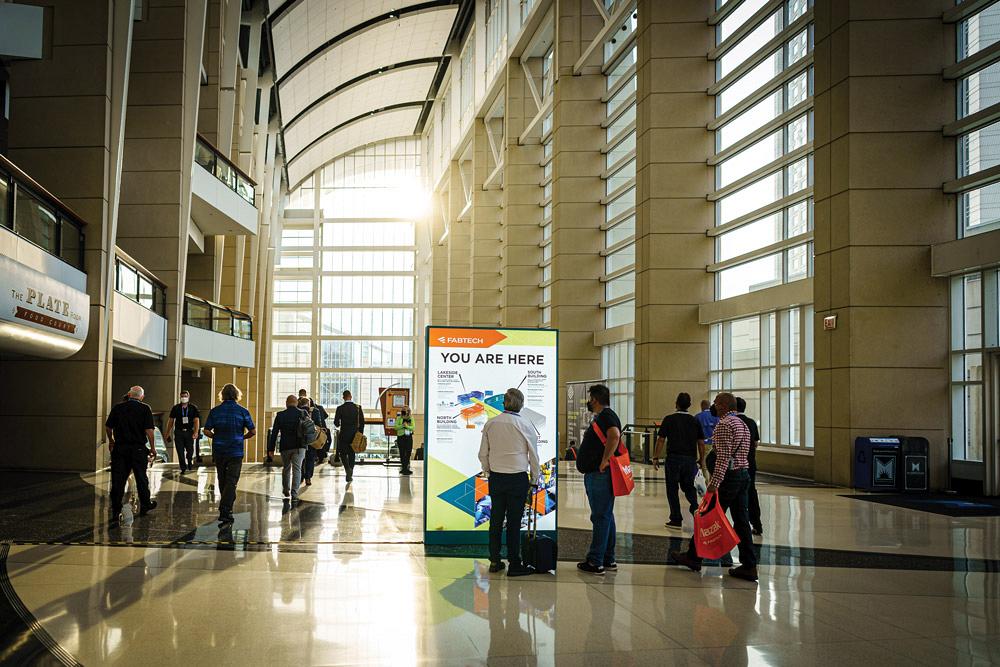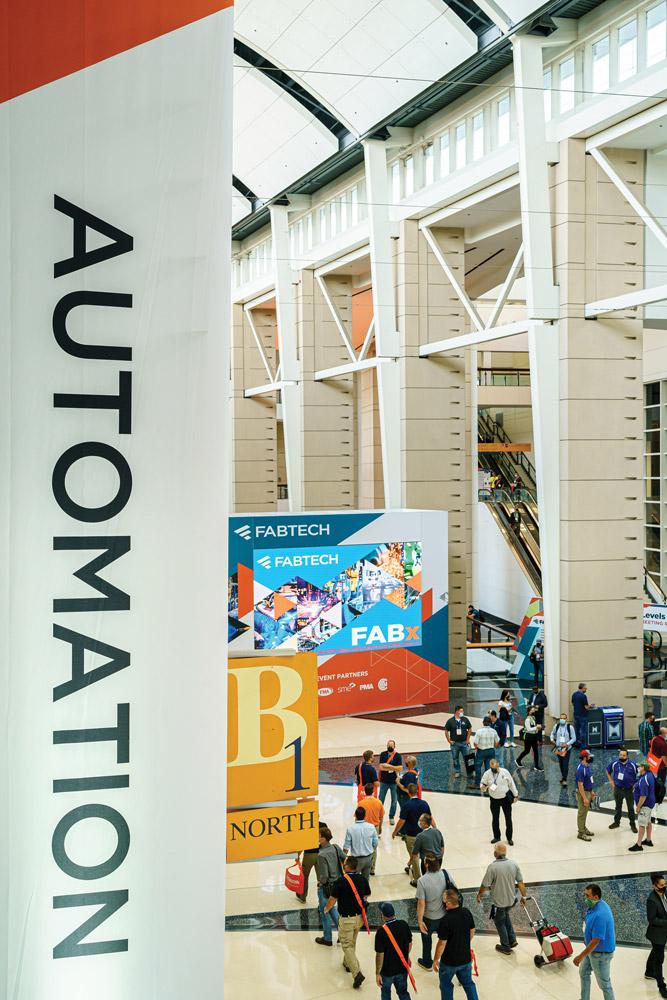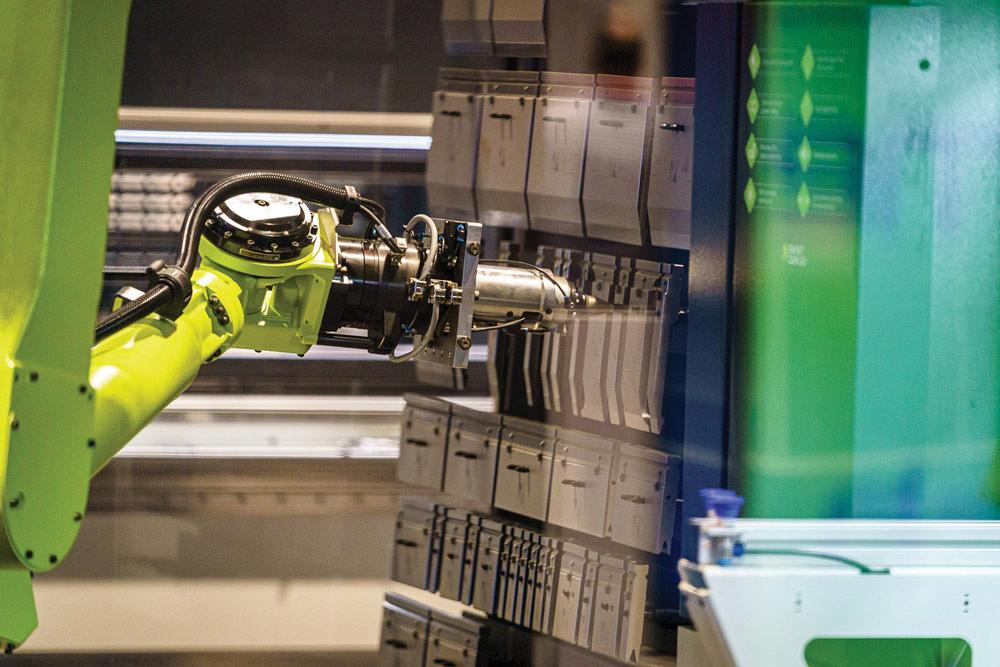- FMA
- The Fabricator
- FABTECH
- Canadian Metalworking
FABTECH 2021: A turning point for automation in metal fabrication?
Why fabricators need good people now more than ever
- By Tim Heston
- November 18, 2021
- Article
- Automation and Software
When the doors to McCormick Place opened in mid-September to host the first FABTECH in two years, an earnest energy permeated the place. The show had few tire kickers. People needed machines and software, yesterday, and many were there to buy.
A number of attendees I spoke with said they had a need for automation to keep them competitive in their niche markets.
No doubt many of the other 24,000 attendees felt the same way. The industry is in a state of urgency that was particularly palpable at the show. The industry lacks people—skilled, semi-skilled, unskilled, it doesn’t matter. To grow, fabricators have no choice but to turn to technology. They’re uncovering new machines, new software, new ways to connect shop systems and processes, and new strategies to build a company culture to make the most out of what technology can offer.
The Dangers of a Shallow Talent Pool
Technology at its best lifts a workforce. Sales per employee rises. As employees learn more and accomplish more, they make more money as they climb the career ladder. Automation in the hands of the curious and creative can lead to great things.
At its worst, technology helps make the unskilled, uninterested, and unengaged marginally productive, at least for a while. Even those who appreciate the technology might find themselves in a dead-end career if they’re never given the right training to grasp the whole picture of metal fabrication, the foundational elements that the shop hands of old had no choice but to learn. They didn’t have software and automation to lean on. A high-tech fab shop with a shallow talent pool looks nice, but it’s just a facade, and it’s certainly not sustainable.
It’s easy to see how all this comes to fruition, especially now as the baby boomers retire and all too often take their knowledge with them. Metal fabrication is undergoing a great generational shift, and knowledge sharing has never been more important. Here, too, technology can help.
At FABTECH, Steve Zubrzycki pointed to the computer screen at his booth. He showed a video of someone operating a machine, bringing the viewer step by step through a certain set of tasks—nothing out of the ordinary there. But then he demonstrated how that video was made. The video wasn’t rough. It incorporated diagrams and subtitles, even translations to different languages. The editing of that video had been accomplished automatically through artificial intelligence (AI).
Zubrzycki is customer success manager at Detroit-based DeepHow (www.deephow.com), a 3-year-old company that’s designed a way to streamline the video recording, editing, and posting process. Using a specialized video capture app, someone with a phone records a shop veteran performing a specific task and uploads the video. From there, DeepHow’s AI edits it to make it part of a manufacturer’s training regimen. The technology exemplifies how old-school craft meets the disruptive technology of the present.
“Our entire goal is to help companies close the skills gap in manufacturing,” Zubrzycki said. “The technology is designed to be scalable across organizations, even globally.”
The Role of Creativity
Such knowledge builds the foundation for true fabrication creativity, which is why many get into the metal fabrication business in the first place (it certainly isn’t to get rich quick). Creativity comes in two forms—craft and process—and these days a fabricator needs both to thrive.
That shop veteran being recorded for DeepHow’s video training drew from years of craftsmanship. With that knowledge, the shop veteran sees a difficult drawing not as an impossibility, but a challenge. So, you want to bend 6061-T6 aluminum into a tubular form without cracking? Instead of throwing up their hands, creative craftspeople visualize how they could incrementally bend it on a press brake with the right tools and careful handling.
Then there’s process creativity, which comes into play when fabricators look at entire processes and aim for holistic improvement, from raw stock to the shipping dock. This is where continuous improvement and Industry 4.0 step into the picture. And as usual, the FABTECH conference had multi-day programs covering each.
This year many of the ideas espoused about Industry 4.0 and disruptive technologies—AI, machine learning, Industrial Internet of Things, and all the rest—had a practical bent. They weren’t pie-in-the-sky concepts.
For instance, Mo Abualio, PhD, managing partner of IoTco, a digital transformation consultancy based in Cincinnati, described a welding application in which inspection cameras viewed welded seat frames and, through AI, learned how to determine whether a weld was good or bad. “The AI was trained to look for good images and burn-through images,” he said, “then send that data immediately back to the [manufacturing execution system].” Most significant, these cameras were neither sophisticated nor expensive. Each cost less than $300—more proof that AI and other disruptive technologies aren’t just for multi-billion-dollar corporations.
The same could be said for a variety of sensing technologies. Abualio described a stamping application that integrated acoustic sensors. They weren’t integrated within the die or press but instead sat stationary several feet away, nowhere near any harsh environment. In other words, the setup was simple, non-intrusive, and inexpensive.
“This application gave us predictive quality using acoustic sensing,” Abualio said, explaining that the bottom of a press stroke produces sound signatures that change when something goes awry. Imperceptible to the naked ear, these differences give evidence of quality issues, and a simple sensor setup can detect them within mere microseconds after they occur.
A New Era
Michael Bell, director of sales at Pemamek LLC (www.pemamek.com) based in Mason, Ohio, pointed to a picture that towered over his booth. It showed a two-station welding setup on an 800-ton steel structure more than 15 m in diameter, between 120 and 130 mm thick. What once required a host of manual welders now is being welded automatically, with three seams being laid down simultaneously over a semi-narrow gap, X bevel configuration, all with adaptive-fill technology.
“One person operates all of that,” Bell said. He emphasized that welders didn’t lose their jobs; the company simply couldn’t find the number of welders it needed to meet demand and so turned to automation.
The example shows the changing nature of the metal fabrication career. Repetitive jobs, even on 800-ton steel structures, are now ripe to be automated. Those who know the fabrication craft are still sorely needed. That one welder managing the automation knew his way around the welding torch, the importance of proper joint prep, and the need for adaptation.
Technology on display at FABTECH 2021 showed an industry in transition, one in which creativity is valued more than ever and new technology empowers those who know the metalworking craft and can appreciate and learn new methods quickly. Judging by the excitement from those who were on the show floor—an exhibit space that hadn’t seen such traffic in more than 18 months—the fun has only just begun.
Senior Editor Tim Heston can be reached at timh@thefabricator.com. FABTECH is organized by five event partners: American Welding Society (www.aws.org), Fabricators & Manufacturers Association Intl. (www.fmamfg.org), SME (www.sme.org), Precision Metalforming Association (www.pma.org), and Chemical Coaters Association Intl. (www.ccaiweb.com). For more on upcoming FABTECH events, visit www.fabtechexpo.com.
About the Author

Tim Heston
2135 Point Blvd
Elgin, IL 60123
815-381-1314
subscribe now


Keep up to date with the latest news, events, and technology for all things metal from our pair of monthly magazines written specifically for Canadian manufacturers!
Start Your Free Subscription- Trending Articles
BlueForge Alliance partners with Nuts, Bolts & Thingamajigs to develop Submarine Manufacturing Camps

Portable system becomes hot tech in heat treatment

Orbital tube welding webinar to be held April 23

Cidan Machinery Metal Expo 2024 to be held in Georgia May 1-2

Corrosion-inhibiting coating can be peeled off after use

- Industry Events
MME Winnipeg
- April 30, 2024
- Winnipeg, ON Canada
CTMA Economic Uncertainty: Helping You Navigate Windsor Seminar
- April 30, 2024
- Windsor, ON Canada
CTMA Economic Uncertainty: Helping You Navigate Kitchener Seminar
- May 2, 2024
- Kitchener, ON Canada
Automate 2024
- May 6 - 9, 2024
- Chicago, IL
ANCA Open House
- May 7 - 8, 2024
- Wixom, MI


















